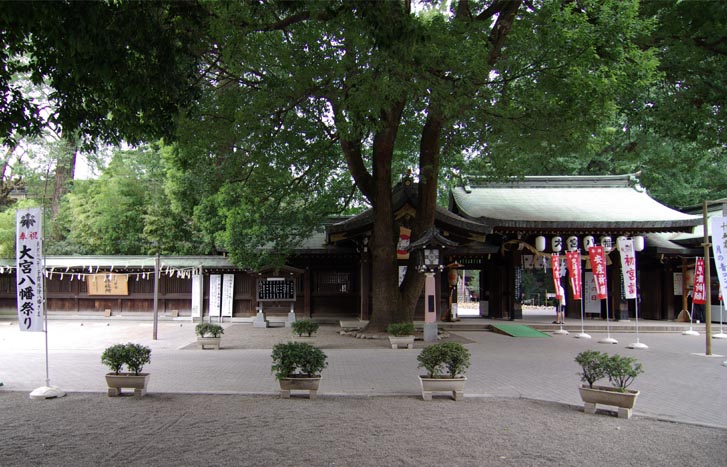
By "Manbow Papa" (Ishikawa Kazuo) < kishik -at- parkcity -dot- ne -dot- jp >
Text originally posted to rec.arts.anime.misc on 27 Oct 2007
This article is reposted here with the author's permission.
In recent years, Shinto related things have been exposing in anime shows more frequently than before. In Rental Magica, Denno Coil, Mokke, Night Wizard, CODE-E and many others, you can see examples. I have visited about 140 jinja [Shinto shrines] in the suburb of Tokyo. I'll show you what I saw and thought.
Warning: Sorry, this post is VERY LONG.
A jinja has one or more Shinto deities to enshrine. About 90 jinja's names had keyword for this. Kamisuzuki-Inari-Jinja, for example, has "Inari" as a keyword to show what kind of jinja it is.
Majority of other 50 names were in a form of: <place name>JINJA
Tokura-Jinja that is in Tokura city, for example.
Top six keywords were:
| Inari | 26 | |
| Hachiman | 21 | |
| Shinmei | 8 | |
| Tenjin | 8 | |
| Benten | 5 | |
| Hikawa | 5 |
Deities enshrined are:
Inari enshrines a deity of farming. Farms have been supporting it for a very long time. The errand is fox.
Genji begun to support Hachiman in the Heian period. When Minamoto-no-Tomoyoshi led an expedition to the North-East Japan to subjugate enemies, he often visited Hachiman to pray his success along the way. After his success, Hachiman became very popular among military families. Many Hachiman in Tokyo still have a legend of his visit. Oomiya-Hachiman-Guu of Suginami for example.

The deity of Tenjin, Sugawara-no-Michizane, is a factual person. He was so brilliant as he got an important position in the Heian Imperial Court when he was very young and deified after he died. Tenjin is still very popular among examinees today.
Benten was found mostly in an island or a projection of land of a pond or a small lake. Benten is a Hindu origin deity of water. Suseribime-no-mikoto, who is a daughter of Susanowo-no-mikoto and the wife of Ookuninushi-no-mikoto, is looked to be the same deity as Benten.
Every Hikawa-Jinja was close to a river. Probably because Susanowo-no-mikoto is famous for having defeated an eight-head python that is, according to some researchers, likely a metaphor of a wild river. People needed Susanowo's power to quell the river.
Jinja are often built on higher place. The highest was Oomatonotsu-no-Tenjinsha of Inagi that has over 100 steep steps to get to the pray house.
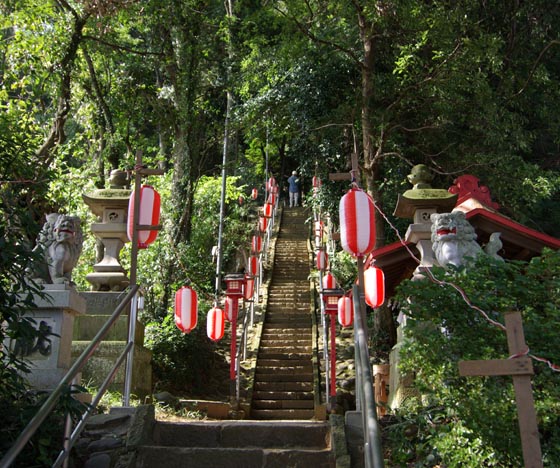
The largest was Ookunitama-Jinja of Fuchuu of which keidai is 100 by 400 meters approximately.
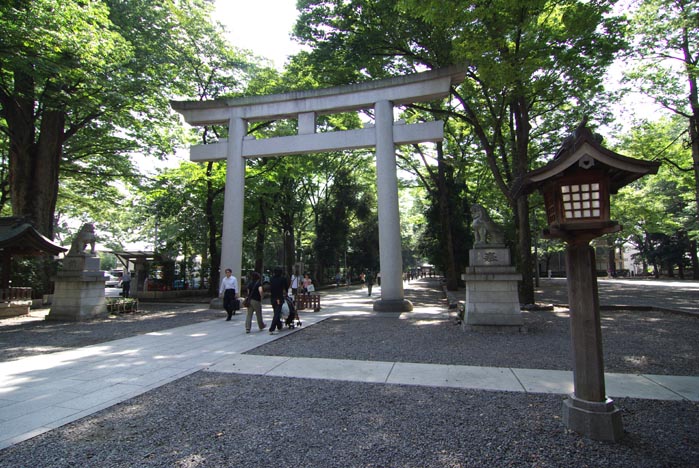
The smallest was Mitarashi-Jinja of Fuchuu. The keidai should be about 1 meter radius on the wall of a hill. Water flowed out from the center of the area. Just above the outlet was a house shaped stone block of which size was looked to be 0.2 by 0.4 meters. The block and a monument were the only artificial structure in the jinja.
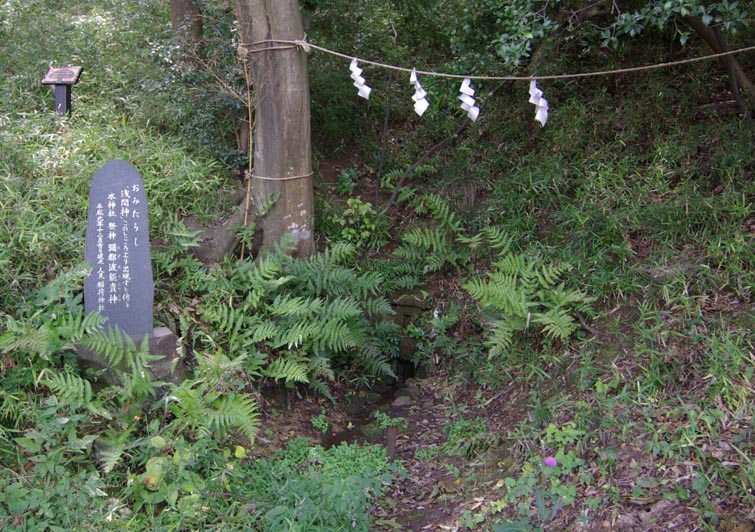
According to the monument of Yasaka-Jinja of Higashimurayama, the cost of moving an old house and building a new house complex was 225 million yen two decades ago.
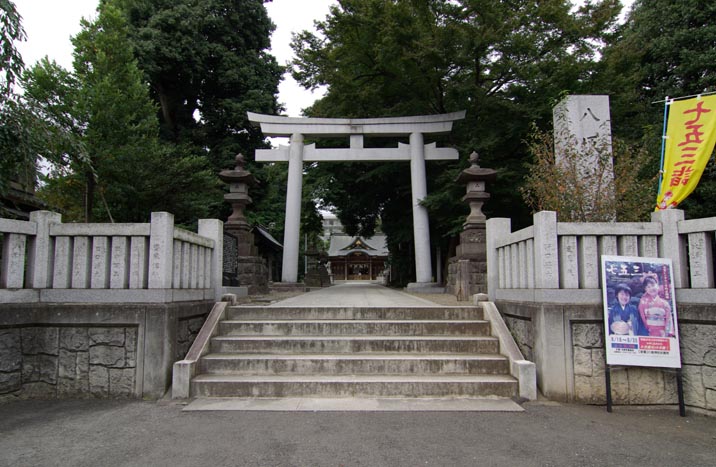
Three sacred treasures that are sign/evidence of Imperial Throne. Yata-no-kagami [mirror], Kusanagi-no-tsurugi [sword] and Yasakani-no-magatama [jewel]. Tennou [Japanese Emperor] is the head of kannushi [priest of jinja]. I saw all three treasures in the altar of the pray house of Tanashi-Jinja.
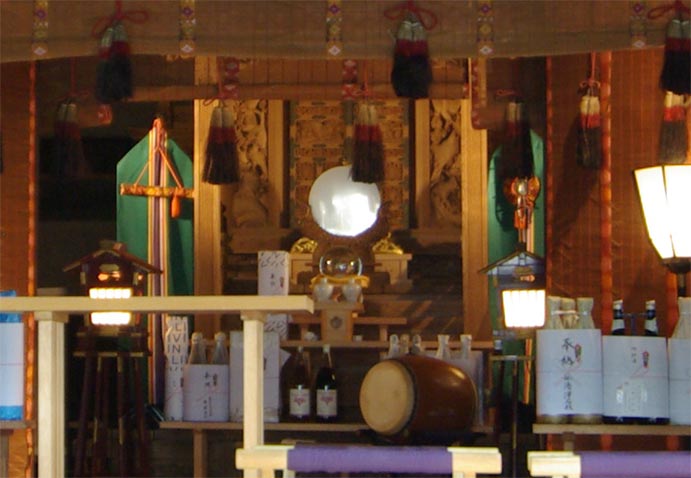
Japan's unique religion based on animism and shamanism. The basic brief is that everything you see, hear and feel has a spirit. Even lifeless things such like natural phenomena, stones and tools have spirit and everything is equal. Humans have no advantage in this context.
Due to its flexible and ununified nature, Shinto accepted many foreign deities from Hinduism, Buddhism etc. Some factual people were also deified.
The main components of Shinto are deities, legends, jinja (or its alternatives like yashiro, hokora etc.), kannushi [priest] and miko [maiden], ceremonies, festivals, pray style and life style.
The most unique idea of Shinto will be "kegare". It's like dirt. You get kegare when you touch to evil or do something forbidden. If you got kegare, you shall pray to a deity for cleaning it up. Otherwise, kegare will spoil your life.
According to the legend, the year of the accesion of the first Tennou, Jinmu, is thought to be 660 B.C. Izumo-Taisha, the oldest jinja, was built in Kamiyo [the age of deity].
In the Yayoi period (3c? B.C. - 3c A.D.), Japan begun to get advanced technology and products from Korea and China, and the Yamato Kingdom was gradually formed in Nara. According to establishment dates that can be confirmed by a written document, the oldest of 140 Jinja I have visited was 111 A.D. of Ookunitama-Jinja of Fuchuu.
In the Kofun (3c - 6c) period, many Korean and Chinese people came to Japan for trading and technology transfer. They bring Buddhism into Japan. It's said that over 150,000 Kofun [old tomb] are in Japan. Kumano-Jinja of Fuchuu has one in the backyeard. This Kofun was thought to be made in the mid seventh century at the earliest. Thus, the jinja itself was likely established in the same period.
In 645, the Yamato Kingdom defined countries in Japan and established each government for every country. They made a main jinja for each country to manage ceremonies.
In the Nara period (710 - 794), the Yamato Kingdom established Shinto by compiling a series of books, Kiki, in order to unify local beliefs, legends, folklores and histories. They tried to control all the countries by sharing the same picture. In order to coordinate Shinto and Buddhism, they encouraged to build a jinja and a temple together in a same place. Shinto gained many foreign deities.
In 1868, the Meiji Restoration Government issued an order of separating jinja from temples in order to control all jinja in Japan. In 1907, to make Shinto the national religion, the Meiji Government declared a rule that no town was able to have more than one jinja at a time. Thus, many jinja were merged and/or disappeared.
Shinto has no "bible". Instead, there are a collection of history books called Kiki that includes "Kojiki", "Nihonshoki", "Shoku-Nihonshoki" etc. The books describe how Izanagi and Izanami created the country, how Susanowo defeated the python, and so on.
Although the premises include many things, they are mostly optional.
Outermost fence to declare its keidai [sacred area].
Symbolic gate showing the border between keidai and zokkai [our world]. Inari sometimes have many red torii over the sando.
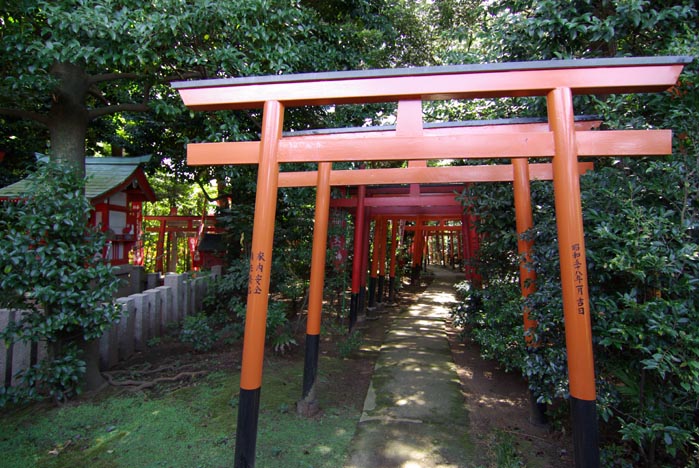
Approach to haiden. Covered by stone boards.
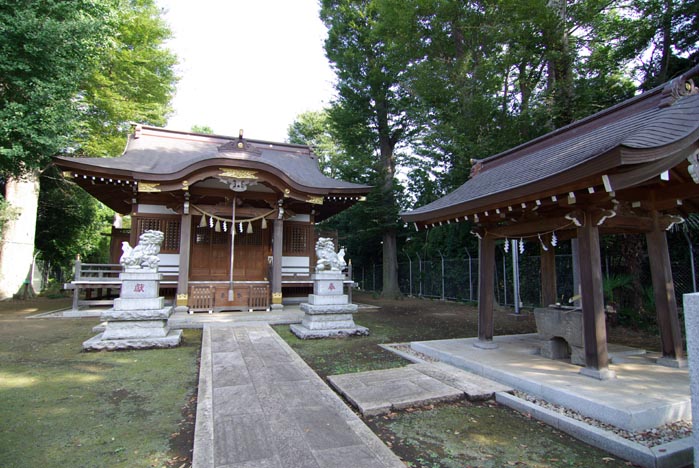
Sacred lantern to illuminate sando. Often, made of stone. Always pair. If a sando is long, enough number of pairs should be provided.
Washing hands tub with a roof supported by four pillars. Water is sometimes supplied by a dragon shaped faucet. Because water is the attribute of dragon.
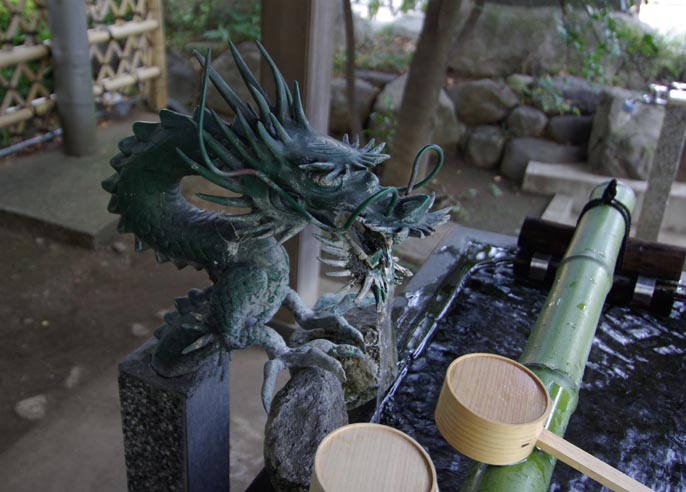
Imperial guardian lion. A pair of statues of an imaginary holy beast looks like a dog. In many cases, one holds a puppy and the other holds a decorated ball under its paw. Inari has statues of fox instead of komainu. Often, fox wears a red bib.
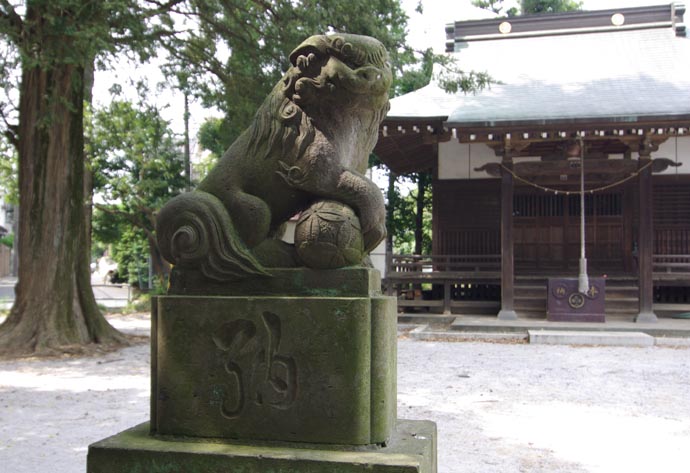
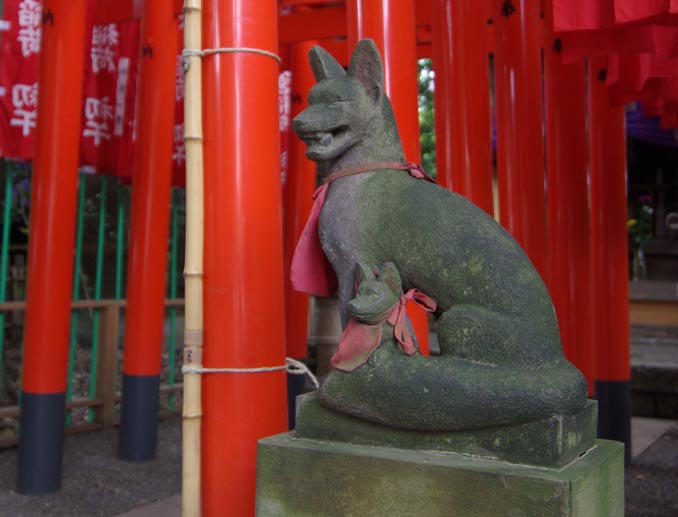
Office for overall management and selling goods like omikuji [fortune slip], omamori [charm], ema [wishing board], hamaya [purifying arrow], etc.
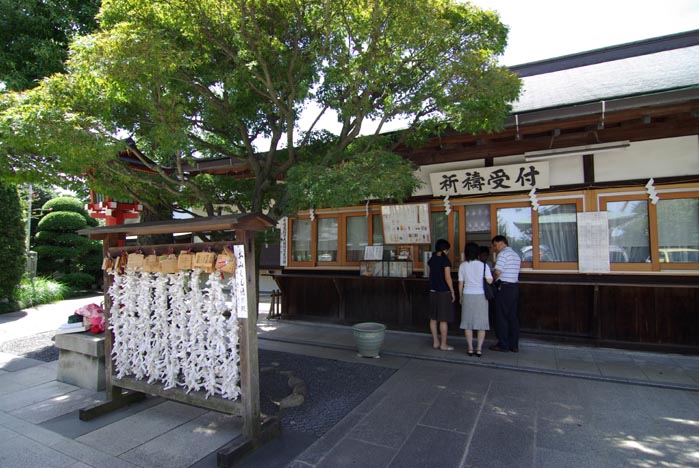
Some jinja had a dancing stage in which traditonal arts such like No, Mai, Gagaku etc. are performed.
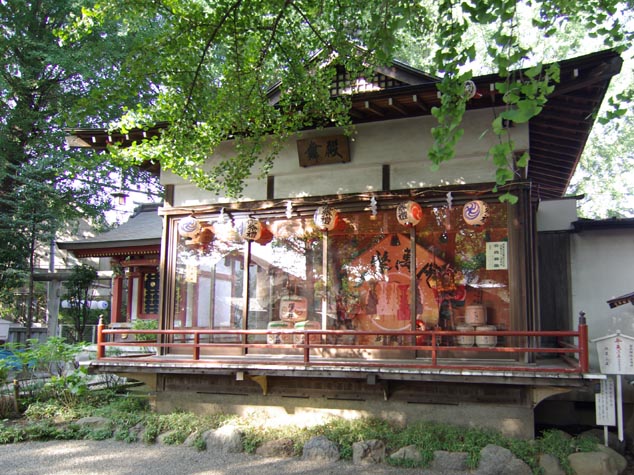
Sumo ring that only two jinja had. Long ago, Sumo was performed in the presence of Tennou.
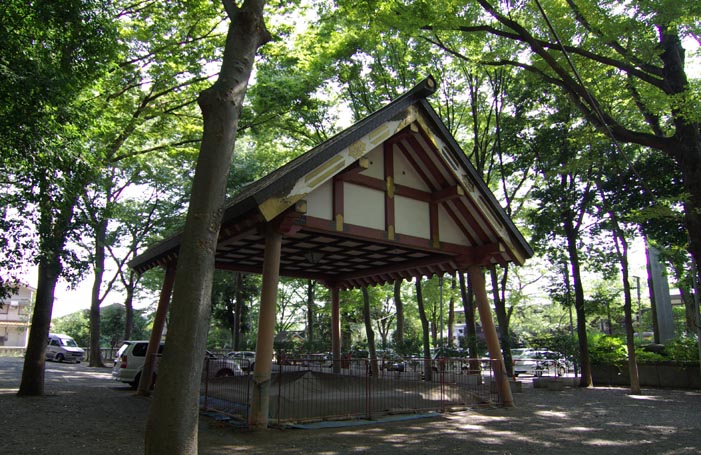
Storehouse of mikoshi [portable shrine]. Mikoshi is carried around the village at festival.
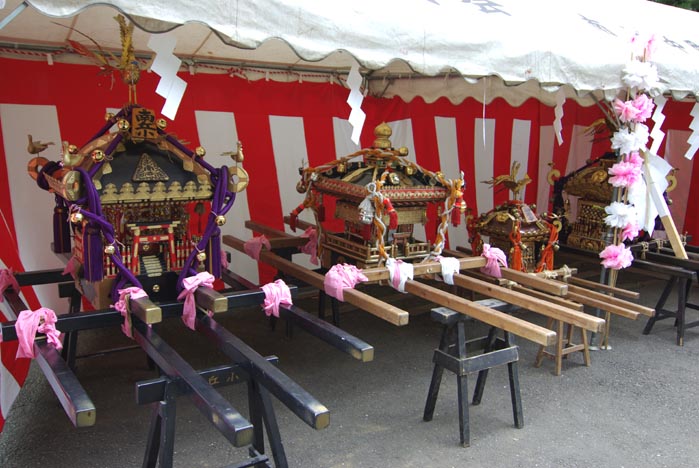
Pray house. A smaller roof is sticking out from the house to hang a large bell and to cover a saisenbako [donation money box]. Visitors pray to a deity in front of this house. Ceremonies such like purification are also performed in the room of haiden. The large wooden beam connected to the pillars that support this roof often had complex and precise sculpture/carving. Typically, a large winding dragon was in the front, elephant like beast was at the both ends and the end of both side-beams had holy lion. Some jinja also had cranes and turtles which are symbol of longevity.
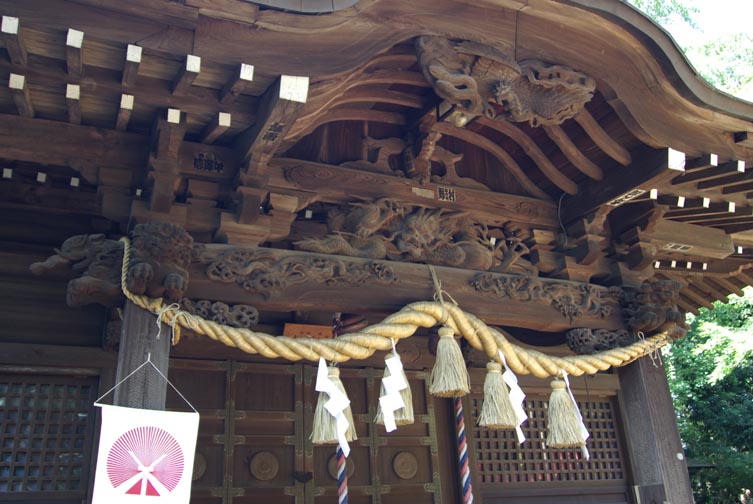
Main house. It's connected to haiden with a roofed passage. Main house has a sacred entity that is the symbol of deity. We primarily can't see the entity in the altar of the house. In a case, it was a wooden stick with shide (crafted white paper). In case of Shouan-Jinja of Suginami, it's said to be a mummy of vixen. The legend says:
Long time ago, there was a temple in the west of this Inari-Jinja. On a hill nearby the temple, a vixen digged a hole and was raising her babies. One day, a guy from the neighboring village caught the babies and ate them. Due to the grief of her separating from the babies, she was found dead with her paw stuck in her mouth laying under the floor of Haiden. Since then, her mummy has been enshrined here as the errand of O-Inari-sama with our great respect.
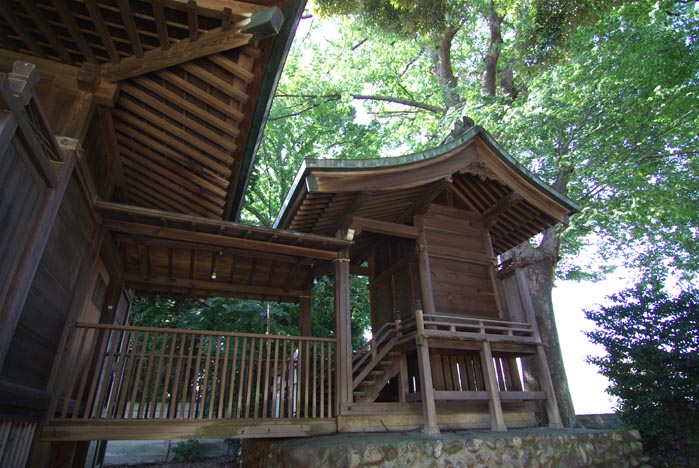
The grove of jinja. Originally, it was believed that deity periodically descends on natural structure such like mountain, forest, pond, rock, waterfall etc. and there was no need of jinja. Under the influence of Buddism, however, people begun to build jinja in sacred forest. So the grove of jinja basically remains the original form of natural forest. Although many jinja doesn't have the grove anymore, they still have fair amount of big trees that shows strong contrast to citizen's houses. As far as I was able to recognize, majority of trees were:
Shinto's sacred tree. A type of camellia. Small branches of sakaki are offered to deity at any events.
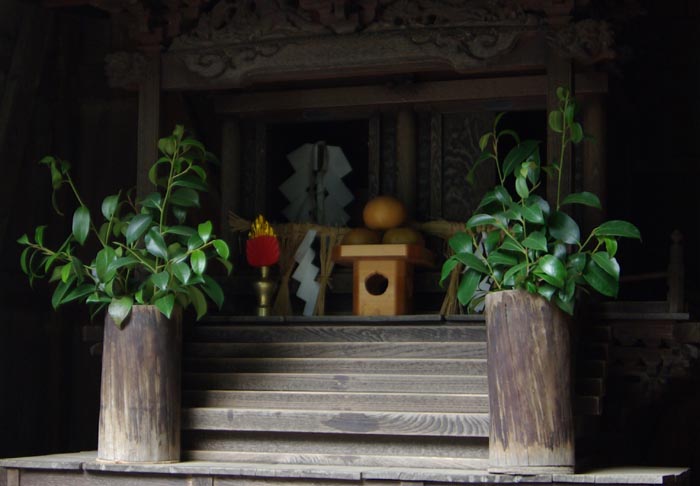
Torreya, a type of yew. Grows tall. Board taken from kaya is used as a precious material for its pale and clean surface. Best Shougi and Go board is made from kaya. It's infamous that a kaya bears good nuts to eat.
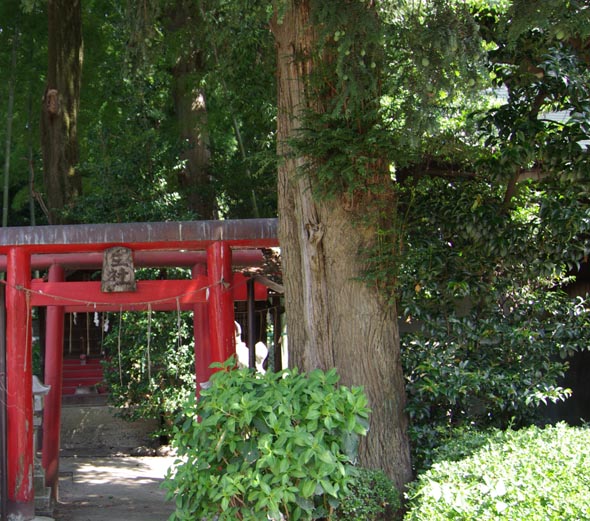
Types of elm. Lives long, grows large. Gorgeous appearance.
Camphor tree. Beautiful shining bright green leaves. Large.
Type of beech. Dense dark evergreen. Kashi is hard and good for lumber.
Conifer. Hinoki produces the best building material for a traditional Japanese house.
Ginkgo. Because icho is hard to burn, it can be a fire wall.
Some of those trees can be used as building material. Because jinja's buildings are made of wood, they don't last for a long time and frequent maintenance is necessary.
A large and especially conspicuous tree in a jinja can be a goshinboku that is supposed to be an incarnation of deity. It usually has shimenawa (rope of rice straw) and shide around its trunk.
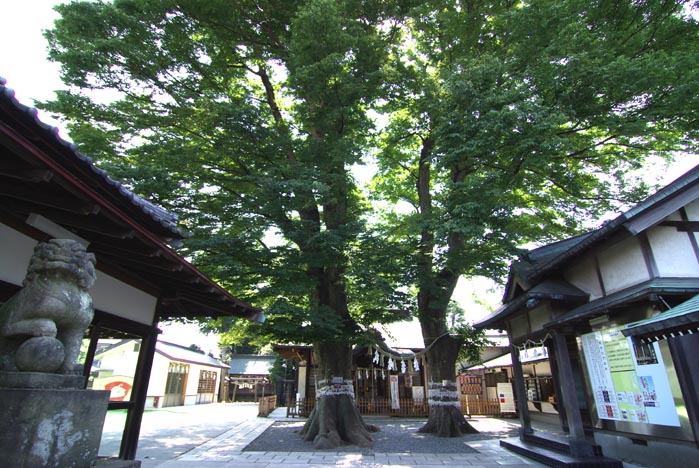
Basic procedure of Shinto's ceremony is:
Popular personal ceremonies are to pray for happiness of a new baby, purifying a bad luck, safety of a new car etc. Minamimachi-Hachiman-Jinja of Kokubunji was setting Joutou-sai [ceremony for setting up framework] for safety of building a new haiden and honden of the jinja.
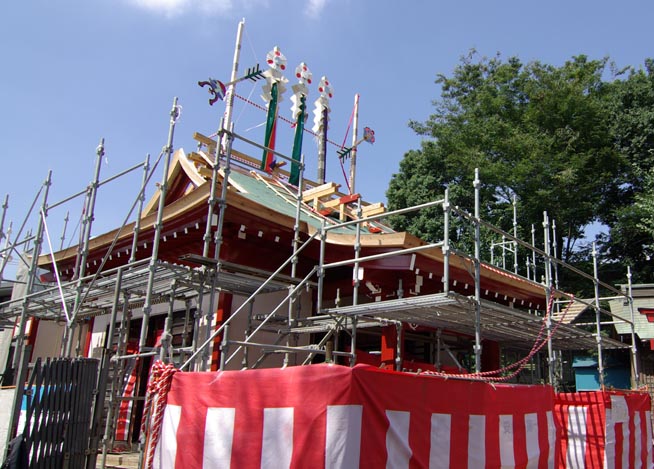
Jinja manages annual fetivals in its keidai. Some festivals are held in coperation of village. Reisai of summer or autumn is especially busy that you can see in many anime.
Dates may vary for convenience.
Thank you for reading.